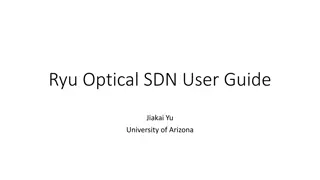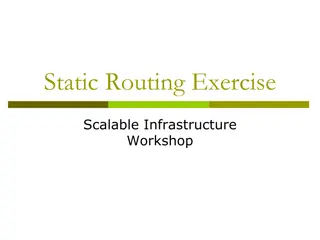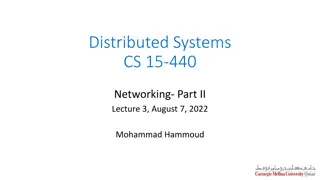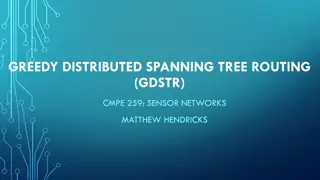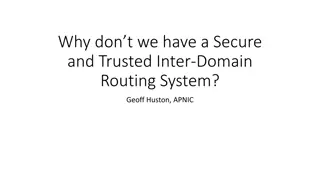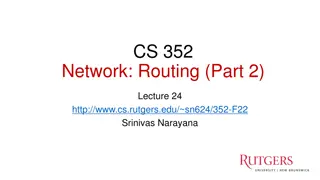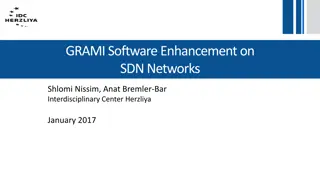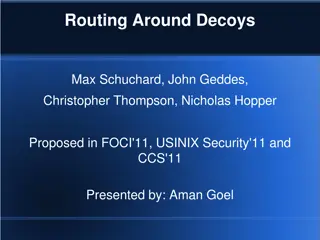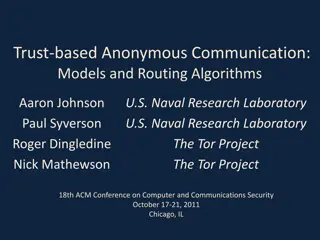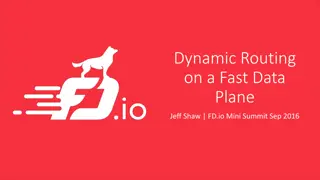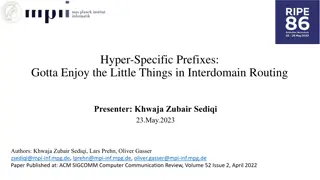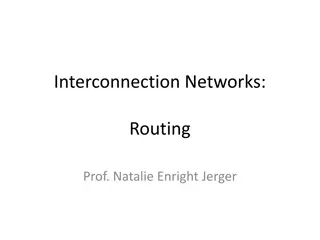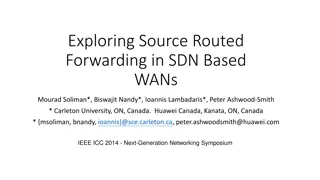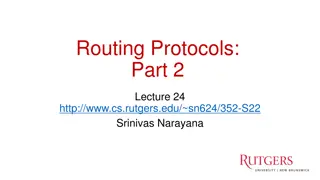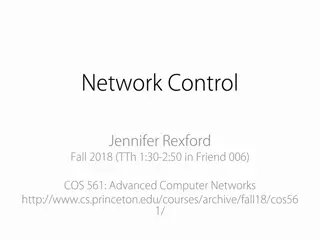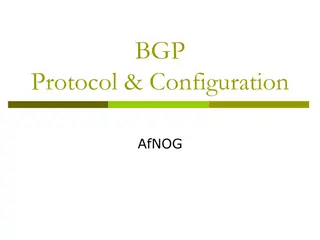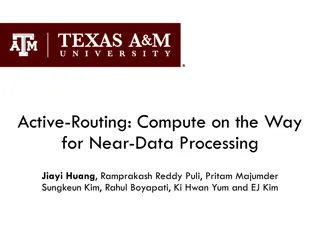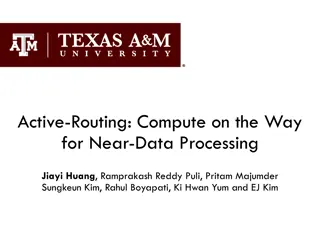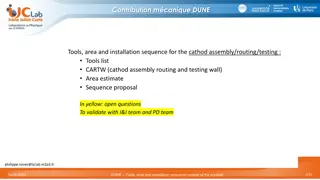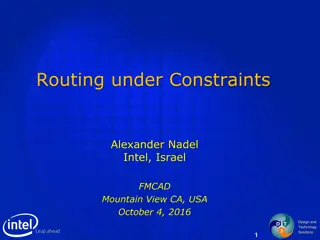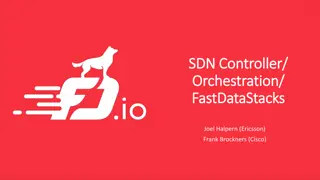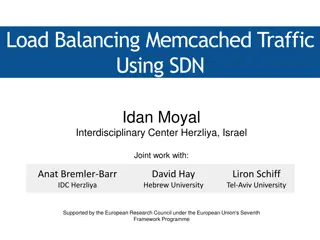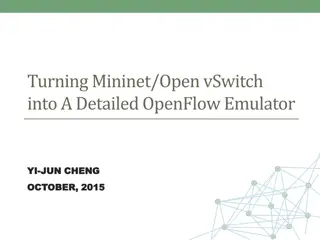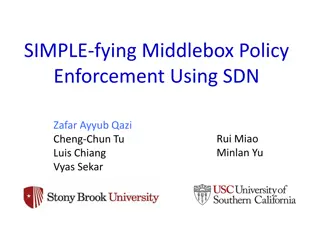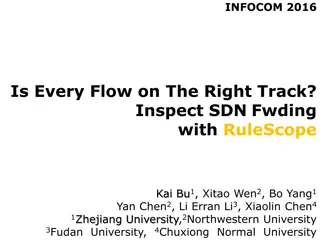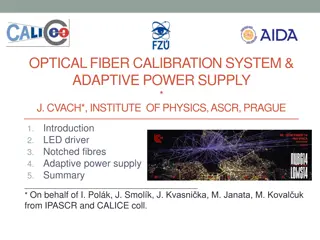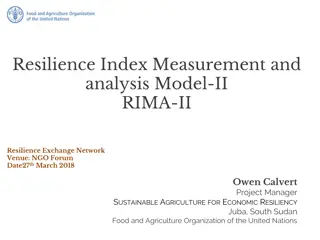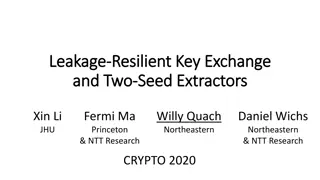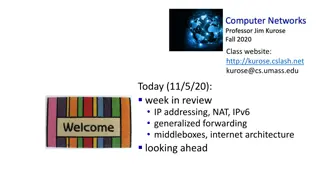Adaptive Resilient Routing via Preorders in SDN
This research paper discusses the challenges of path-based routing in modern networks and introduces a novel approach called Adaptive Resilient Routing via Preorders in Software-Defined Networking (SDN). The authors emphasize the limitations of traditional routing schemes, the importance of resilient routing in the face of network failures, and the benefits of adopting a proactive and adaptive routing strategy. By incorporating preorders into the routing process, the proposed method aims to enhance network resilience and optimize performance in dynamic environments.
Download Presentation

Please find below an Image/Link to download the presentation.
The content on the website is provided AS IS for your information and personal use only. It may not be sold, licensed, or shared on other websites without obtaining consent from the author. Download presentation by click this link. If you encounter any issues during the download, it is possible that the publisher has removed the file from their server.
E N D
Presentation Transcript
Adaptive Resilient Routing via Preorders in SDN Eman Ramadan, Hesham Mekky, Braulio Dumba and Zhi-Li Zhang University of Minnesota
Agenda Introduction Limitations of Path-based Routing Routing via Preorders Realization in SDN Conclusion
Introduction Adding more switches and links to networks Increases available parallelism An effective way to meet insatiable application demands for bandwidth Leads to a far richer network topology (often many diverse paths between two end points) However, with the growing network scale The probability of failures becomes higher Resilient routing e.g., via pro-active fast failover mechanisms is imperative, to meet ever stringent availability, reliability and QoS requirements demanded by applications
Path-based Routing Doesnt Work! Existing routing schemes for communication & SCADA control networks are path-based! i. compute one path (e.g., shortest) or multiple paths from s to d ii. route traffic along the path or paths, e.g., via IP or MPLS protocol Fundamental Limitations of Conventional Path- based Routing: i. paths are rigid: must be precisely specified a seq. of nodes & links ii. paths are fragile: failure of any node or link renders it invalid!
Path-based Routing Doesnt Work! Fundamental Limitations of Conventional Path-based Routing: i. paths are rigid: must be precisely specified a seq. of nodes & links ii. paths are fragile: failure of any node or link renders it invalid! Toy Network Example O(2L) many (shortest) paths of length 2L! v6 v10 v2 v4L-2 v3 v5 v7 s=v1 d=v2L+1 v8 v12 v4 v4L
Path-based Routing Doesnt Work! Fundamental Limitations of Conventional Path-based Routing: i. paths are rigid: must be precisely specified a seq. of nodes & links ii. paths are fragile: failure of any node or link renders it invalid! Toy Network Example v6 v10 v2 v4L-2 v3 v5 v7 s=v1 d=v2L+1 v8 v12 v4 v4L
Path-based Routing Doesnt Work! Fundamental Limitations of Conventional Path-based Routing: i. paths are rigid: must be precisely specified a seq. of nodes & links ii. paths are fragile: failure of any node or link renders it invalid! Toy Network Example v6 v10 v2 v4L-2 v3 v5 v7 s=v1 d=v2L+1 v8 v12 v4 v4L
Path-based Routing Doesnt Work! Fundamental Limitations of Conventional Path-based Routing: i. paths are rigid: must be precisely specified a seq. of nodes & links ii. paths are fragile: failure of any node or link renders it invalid! Toy Network Example v6 v10 v2 v4L-2 v3 v5 v7 s=v1 d=v2L+1 v8 v12 v4 v4L
Path-based Routing Doesnt Work! Fundamental Limitations of Conventional Path-based Routing: i. paths are rigid: must be precisely specified a seq. of nodes & links ii. paths are fragile: failure of any node or link renders it invalid! Toy Network Example: fairly robust topology v6 v10 v2 v4L-2 v3 v5 v7 s=v1 d=v2L+1 v8 v12 v4 v4L
Path-based Routing Doesnt Work! Fundamental Limitations of Conventional Path-based Routing: i. paths are rigid: must be precisely specified a seq. of nodes & links ii. paths are fragile: failure of any node or link renders it invalid! Toy Network Example v6 v10 v2 v4L-2 v3 v5 v7 s=v1 d=v2L+1 v8 v12 v4 v4L
Path-based Routing Doesnt Work! Fundamental Limitations of Conventional Path-based Routing: i. paths are rigid: must be precisely specified a seq. of nodes & links ii. paths are fragile: failure of any node or link renders it invalid! Toy Network Example v6 v10 v2 v4L-2 v3 v5 v7 s=v1 d=v2L+1 v8 v12 v4 v4L
Path-based Routing Doesnt Work! Fundamental Limitations of Conventional Path-based Routing: i. paths are rigid: must be precisely specified a seq. of nodes & links ii. paths are fragile: failure of any node or link renders it invalid! Toy Network Example v6 v10 v2 v4L-2 v3 v5 v7 s=v1 d=v2L+1 v8 v12 v4 v4L
Path-based Routing Doesnt Work! Fundamental Limitations of Conventional Path-based Routing: i. paths are rigid: must be precisely specified a seq. of nodes & links ii. paths are fragile: failure of any node or link renders it invalid! Toy Network Example v6 v10 v2 v4L-2 v3 v5 v7 s=v1 d=v2L+1 v8 v12 v4 v4L
BeyondPath: Can We Do Better? Fundamental Limitations of Conventional Path-based Routing: i. paths are rigid: must be precisely specified a seq. of nodes & links ii. paths are fragile: failure of any node or link renders it invalid! What about using a Routing DAG (directed acyclic graph)? i. no need to pre-specify any specific path ii. any outgoing link in the routing DAG can be dynamically utilized Toy Network Example v6 v10 v2 v4L-2 v3 v5 v7 s=v1 d=v2L+1 v8 v12 v4 v4L
BeyondPath: Can We Do Better? Fundamental Limitations of Conventional Path-based Routing: i. paths are rigid: must be precisely specified a seq. of nodes & links ii. paths are fragile: failure of any node or link renders it invalid! What about using a Routing DAG (directed acyclic graph)? i. no need to pre-specify any specific path ii. any outgoing link in the routing DAG can be dynamically utilized Toy Network Example v2 v5 v3 v6 v10 v4L-2 v7 s=v1 d=v2L+1 v8 v12 v4 v4L Can survive arbitrary link/node failures as long as they do not disconnect s and d!
Routing DAGs Sufficient for Resiliency? Routing DAG (directed acyclic graph) i. no need to pre-specify any specific path ii. any outgoing link in the routing DAG can be dynamically Sufficient to guarantee optimal resiliency for any topology? i.e., ensure data delivery from s to d under arbitrary failures as long as they do not disconnect the two nodes? New (slightly modified) Toy Network Example v6 v10 v2 v4L-2 v3 v5 v7 s=v1 d=v2L+1 v8 v12 v4 v4L
Routing DAGs Sufficient for Resiliency? Routing DAG (directed acyclic graph) i. no need to pre-specify any specific path ii. any outgoing link in the routing DAG can be dynamically Sufficient to guarantee optimal resiliency for any topology? i.e., ensure data delivery from s to d under arbitrary failures as long as they do not disconnect the two nodes? New (slightly modified) Toy Network Example v6 v10 v2 v4L-2 v3 v5 v7 s=v1 d=v2L+1 v8 v12 v4 v4L
Routing DAGs Sufficient for Resiliency? Routing DAG (directed acyclic graph) i. no need to pre-specify any specific path ii. any outgoing link in the routing DAG can be dynamically Sufficient to guarantee optimal resiliency for any topology? i.e., ensure data delivery from s to d under arbitrary failures as long as they do not disconnect the two nodes? New (slightly modified) Toy Network Example v6 v10 v2 v4L-2 v3 v5 v7 s=v1 d=v2L+1 v8 v12 v4 v4L
Routing DAGs Sufficient for Resiliency? Routing DAG (directed acyclic graph) i. no need to pre-specify any specific path ii. any outgoing link in the routing DAG can be dynamically Sufficient to guarantee optimal resiliency for any topology? i.e., ensure data delivery from s to d under arbitrary failures as long as they do not disconnect the two nodes? New (slightly modified) Toy Network Example v6 v10 v2 v4L-2 v3 v5 v7 s=v1 d=v2L+1 v8 v12 v4 v4L
Routing DAGs Sufficient for Resiliency? Routing DAG (directed acyclic graph) i. no need to pre-specify any specific path ii. any outgoing link in the routing DAG can be dynamically Sufficient to guarantee optimal resiliency for any topology? i.e., ensure data delivery from s to d under arbitrary failures as long as they do not disconnect the two nodes? New (slightly modified) Toy Network Example v6 v10 v2 v4L-2 v3 v5 v7 s=v1 d=v2L+1 ? v8 v12 v4 v4L
Routing DAGs Sufficient for Resiliency? Routing DAG (directed acyclic graph) i. no need to pre-specify any specific path ii. any outgoing link in the routing DAG can be dynamically Sufficient to guarantee optimal resiliency for any topology? i.e., ensure data delivery from s to d under arbitrary failures as long as they do not disconnect the two nodes? New (slightly modified) Toy Network Example v6 v10 v2 v4L-2 v3 v5 v7 s=v1 d=v2L+1 v8 v12 v4 v4L
Routing via Preorders Routing Preorder Mathematically, a preorder on a node set ? ? is a binary relation that is reflective and transitive, for any ? ?,? ? d, ? a path between s, d via u Routing Preorder Graph (PrOG) Directed graph associated with a routing preorder d = O B A C F D E G H I s = J
Routing via Preorder & PrOG Routing Preorder Routing Preorder Graph (PrOG) Traffic forwarding Split proportionally across outgoing links Bi-directed links generally not used under normal operations; invoked (along one direction) under failures C E B s = A d = G F D
Routing via Preorder: Failure Handling Failure Handling Process: Upon failures, use alternative outgoing links if exist C E B s = A d = G F D
Routing via Preorder: Failure Handling Failure Handling Process: Upon failures, use alternative outgoing links if exist If a node becomes a sink , de-activate incoming links C No Need for Global Topology Information Exchange & Route Recomputation E B s = A d = G F D
Routing via Preorder: Recovery Process Recovery Process: If a node/link recovers, re-activate outgoing links C E B Guarantee to Restore to the Original Routing State s = A d = G F D
Optimal Resilient PrOG Construction with Latency Constraints C C E B E B Questions: do such PrOGS exist? If yes, can they be constructed in polynomial time? d = G s = A s = A d = G F F D D H K I J Primary PrOG Backup PrOG
Realization in Emerging Software-Defined Networks (SDNs) The controller computes the routing preorder (satisfying latency constraints), then installs the corresponding rules in the relevant switches Each switch forwards packets using the match- action data plane abstraction Small functionality added to switches to maintain and update some internal states, and generate activation and deactivation tags Switches perform some actions to handle link activation, deactivation and failure
Resilient Routing via Preorders: Packet Forwarding Each switch/router maintains a set of routing rules and states Each packet carries two header fields Eligible outgoing links at node u for forwarding packet to d: Upon failure, update both header fields before rerouting
Simple Demonstration & Evaluation Routing via preorder implemented in Mininet with slightly modified Open vSwitch (OVS) using v.2.4 C E B Simple Demonstration: s = A d = G F D
Realization in SDN: Rule Examples Group Table Flow Table Match Action Group Id Group Type Action Bucket State src=A, dst=G, in_port = A Group: 100 Group: 200 Group: 300 Group 400 Active Active Active fast failover src=A, dst=G, in_port = B Group: 100 100 - Invoke deactivation - Group: 100 src=A, dst=G, in_port = E Output: F Output: E Active Active 200 select - Invoke deactivation - Group: 100 src=A, dst=G, in_port = F Output: J Active 300 select Match Action - Output: in_port - Invoke deactivation Active Activation tag [src, dst, in_port] Invoke activation 400 select Deactivation tag [src, dst, in_port] Invoke deactivation C Match-action rules for switch D E B s = A d = G F D
Simple Demonstration & Evaluation C Simple Demonstration: a UDP traffic generator at host h1, attached to node A, sends datagrams to host h2, attached to node G Traffic lasts for 20 seconds, sending around 90 pks/sec E B s = A d = G F D
Simple Demonstration & Evaluation C Simple Demonstration: a UDP traffic generator at host h1, attached to node A, sends datagrams to host h2, attached to node G Traffic lasts for 20 seconds, sending around 90 pks/sec E B s = A d = G F D
Simple Demonstration & Evaluation C Simple Demonstration: a UDP traffic generator at host h1, attached to node A, sends datagrams to host h2, attached to node G Traffic lasts for 20 seconds, sending around 90 pks/sec E B s = A d = G F D
Simple Demonstration & Evaluation C Simple Demonstration: a UDP traffic generator at host h1, attached to node A, sends datagrams to host h2, attached to node G Traffic lasts for 20 seconds, sending around 90 pks/sec E B s = A d = G F D
Simple Demonstration & Evaluation C Simple Demonstration: a UDP traffic generator at host h1, attached to node A, sends datagrams to host h2, attached to node G Traffic lasts for 20 seconds, sending around 90 pks/sec E B s = A d = G F D
Simple Demonstration & Evaluation C Simple Demonstration: a UDP traffic generator at host h1, attached to node A, sends datagrams to host h2, attached to node G Traffic lasts for 20 seconds, sending around 90 pks/sec E B s = A d = G link up F D
Conclusion Proposed a new routing paradigm routing via preorders Circumvents the limitations of conventional path-based routing schemes Effectively takes advantage of topological diversity inherent in a network with rich topology for adaptive resilient routing Meets the QoS requirements (e.g., latency) of applications or flows Resilient against arbitrary k link or node failures (if network not partitioned) Realized routing via preorders in SDN networks using the match-action data plane abstraction, with a preliminary implementation of it in Mininet



